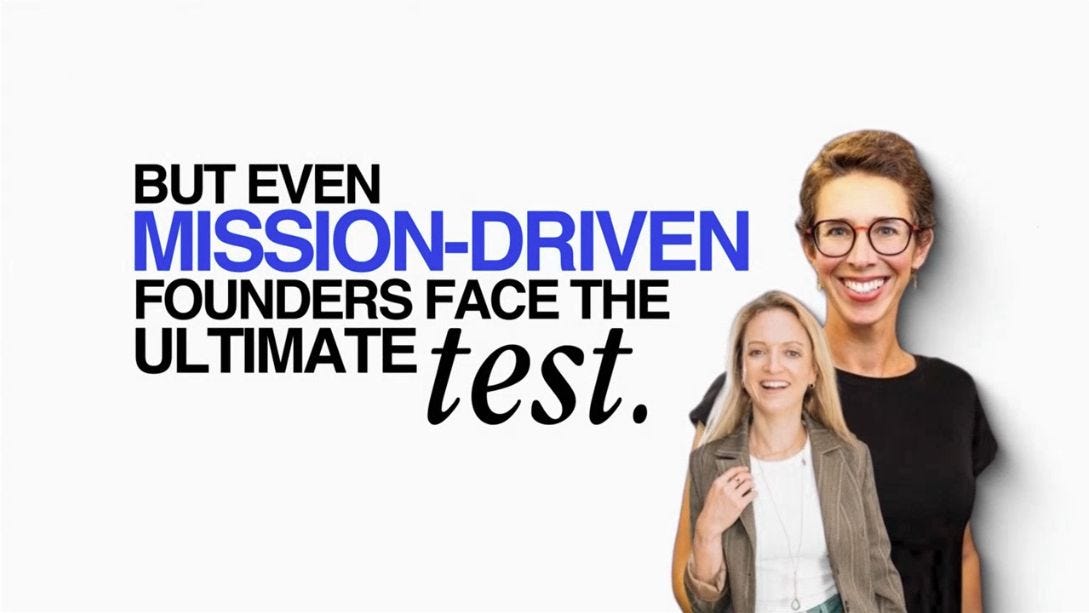Greetings to 3k+ Impact Supporters! 🌍 It’s August Solliv 👋 Today’s article and podcast are part of The Impact Highlight Series - a podcast series that I run with EUVC (Andreas Munk Holm) and ImpactVC/Better Society Capital (Douglas Sloan & Ellie Broad) where we are starting with 10 interviews with some of the most prolific impact investors in Europe. In this series, I don’t write a full article as you have been used to, but you get all the show notes from the interviewee below 🥳
The interview is with Emma Steele (Partner at Ascension) and Emily Trant (Head of Impact at Wagestream), two vocal champions for mission-aligned tech in Europe. In this episode, we explore the nuances of building and backing commercial businesses that generate genuine social value. Emma and Emily reflect on where the commercial model does work for impact, where it doesn’t, and why intent matters as much as outcomes 🌱
Agenda:
Meet Emma & Emily: Impact VC meets operating at scale
What Is “Impact” Anyway? And why Ascension never used the label
Wagestream’s Model: Serving those who can’t pay—at scale
Market Failures & Margin Models: Why commercial still wins
Data That Matters: From savings behavior to sleep quality
Charity vs Commercial: The tension no one likes to talk about
Impact Boards: How to make them useful (hint: be honest)
The Venture Fit: Why scale and impact aren’t opposites
Calling Future Founders: Be intentional from day one
A look at the person behind…
Who is Emily Trant?
I am an optimist through and through
I’ve spent the last 20+ years working in fintech of all different shapes, and just over 5 years ago realised I simply didn’t care about working on stuff that helped rich people get a bit richer.
As I’ve got further in my career (and my life) I’ve come to be quite thoughtful of the value exchange of work. What am I giving and what am I getting in exchange?
Who is Emma Steele?
Thrive in the uncomfortable, Always stay curious, Be good at sales ! authentic relationships are everything
How are you seeing venture-backed companies playing a role in tackling social issues? Where can they be most effective? Where are the limits to that? And specifically on combatting income/wealth inequality?
Emma:
Where the social inequality is created or exacerbated by a market failure that can be solved through tech this is the sweet spot where you can truly tackle inequality with venture
Tech transform supply chain economics, delivery costs, transparency, access
Tech & venture backed tech companies can play a huge role in introducing more efficient more transparent services where the whole economics of the value chain can be transformed through being tech enabled and therefore priced differently distributed differently. This can be done for example with using AI to optimise energy consumption, API & Cloud technology can disrupt the way in which financial services are priced and distributed. It can also transform Healthcare delivery and effectiveness, education etc. Open Banking also rethinks information asymmetries between people and how this drives a lot of access issues
Could be lower margin products but serving mass market is a big opportunity
Emily:
There are some parts of tackling social issues that can only be solved by government intervention and/or regulation. Eg I interviewed Sara Davies from the Bristol University PFRC about calculating the poverty premium and view is that there should not be markets in essential services. Wherever there are markets there will be price disparity, and this disparity and innovation tends not to favour poorer customers.
Talk about the difference between a charity and a social impact company. Charities may be focused on solving social problems where there isn’t a big business case. But for social impact companies, the impact and the commercial return are connected, so there’s a role for VCs to help drive scale.
Do you think companies looking to tackle social issues and inequalities can be truly ‘venture scale’? Is there an inherent ‘hands-on’ part of social solutions that require human interactions and limits scale? Can you give one or more examples of companies at venture scale with true social impact?
Emma:
…Obviously the Wagestream example! Tembo, Switchee another set of examples where Mission- drive goes in lockstep with commercial scale. More efficient services mean more time and margin to serve vulnerable customers
…all our solutions are looking to use tech innovation which disrupts the way a product or service is distributed which carries scales inherently - we are solving for major market failures that happen to have deep societal impact. The difference with other funds is around the intentionality of the investment but the lens is as commercial if not more.
On that same theme, what does being an impact company mean to you? And linked to that, has putting impact at the heart of what you do helped or hindered in driving the commercial success of Wagestream?
Emily:
Being an impact company means having a commercial model that is sustainable over the longer term - because you are doing right by your customers. It doesn’t mean being uncommercial.
On the topic of how impact has helped. . .
Everything we measure creates commercial value for Wagestream. It works because our impact helps us scale, and our scale helps us achieve more impact.
Let me give an example of how our impact measurement links to our growth. In our specific case, because we are B2B2C, our buyer is not our service user.
Our buyer is in an HR or a People function. They might be procuring benefits or in charge of reward
They’re higher earners, they are financially included, their pay cycle tends to align nicely with their bills, so they don’t really understand how our product is helpful. They don’t have the lived experience of coping with volatile pay within a financial services ecosystem that’s been built by and for people with a stable monthly income.
In fact they worry a lot that what we’re doing is harmful. I’m pretty sure 100% of our 1,000+ clients have all voiced the same concern. If we give people more control over their money, surely it will lead to overspending and debt, and then they, the employer, will be on the hook for allowing this app to be distributed to their workforce. People won’t learn to budget, and instead will be in a worse position the following payday.
This simply isn’t what happens, and in fact we have the opposite impact. People spend less, work more, are more mindful of their spending habits, are better able to budget because they have both the data and the cashflow to manage incomings and outgoings, they save more - often for the first time - and they build a habit of engaging with money.
We spend a huge amount of time and energy gathering the evidence for our impact, including spending time understanding the outlier cases where the impact might not be positive. Because people are people, and although our majority use case is very positive, there will always be exceptions.
Our impact data is essential to our business. It helps us:
Give our buyers comfort that they’re doing the right thing by procuring our service
Help our buyers feel confident that it’s helpful to promote the service to their employees and to work with us to create high engagement and high adoption.
Build a better product that is both commercially successful and good for people.
Can you lift the curtain a little bit on the investor <> investee dynamic around impact? Emma, how do you approach supporting Emily and Wagestream as an impact investor? Emily, what has been most helpful? What have some of the challenges been and how have you navigated those?
Emma:
…We have I think an amazing relationship where It’s a really two way street where we support each other with our respective goals - at the beginning we introduced Wagestream to the key stakeholders that could help them shape their impact data governance but over time it actually shifted as Wagestream invested more and more in their impact function they quickly became a fantastic source of research themselves ! Having similar mission goals mean that we can constantly feed off and learn from each other’s journeys. Obviously we’re now a tiny part of the cap table for Wagestream but the team has always made us feel valued and appreciated over the years - I think being impact aligned really does create unique relationships
Emily:
We have a really collaborative relationship, and I’ve been super transparent with Emma & team when I thought that the early days of our impact reporting was a bit whiffy…
The ascension team are really plugged into the ecosystem and have really helped as a connector, getting us to meet other businesses that are helpful
And in the early days it was the credibility of the Fair by Design fund, including LPs, that really made a difference. The fact that we were backed by charitable investors brought a huge amount of comfort to our early clients and we know that it’s one of the reasons we were able to sign big lighthouse clients before we had our impact track record.
Best tip for impact VC investors
Emily:
1: Find the businesses where impact is central to the growth story, not a side note.
2: Be pragmatic about impact measurement.
I know this may be not what you want to hear as an investor, because you want to measure the same data across your portfolio companies. But if you force top down metrics, you’ll end up with box ticking exercises.
We have to do this in some other areas, for example our environmental impact or our internal diversity metrics. But these data points are NOT the heartbeat of our impact story and they don’t drive business progress, so I don’t spend any energy on them and frankly don’t care very much about their direction of travel.
I care A LOT about the social impact of our product and how that affects the people who use it. This is where all of my time and energy goes.
Figure out what makes each company special, how they’ll drive value out of better data, and the onus is on you to work out how you can use that data in aggregate.
Emma:
Adding to Emily - founder intent counts a whole lot here - generalist portfolio may have impact companies on their books without even realising - and potentially missing out on telling those stories and understanding the real scale of what their founders are achieving. So find out about what really drives founders and what their big picture vision is.
If it’s something they want to pay attention to they need to understand what problems they are wanting to focus on and which business models and sectors will be attached to that and have a theory of change for those problems. We found that being thesis driven is much more effective way of doing impact - it groups people together working towards the same goal, it means your reporting and measurements are much more focused and you become a beacon of opportunity for founders solving for those same problems
Best tip for investors who want to invest in solutions that fight poverty/societal inequality?
Emma:
Important to note that these are inherently ‘political’ topics where strong opinions about what work or doesn’t work for people is so it’s really important to think about your target audience here and integrate user voice in how you make investments (example of our Bulbshare partnership)
Also think about the timelines of an investment - an innovation may not immediately reach our target audience perhaps because it needs scale to be fully affordable but if there is founder intent and the right distribution channels to get there (for example for a healthtech solution) - then you have to look at the big picture














Share this post